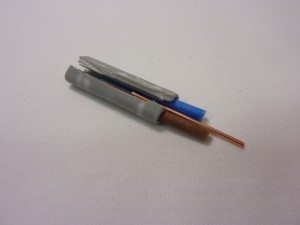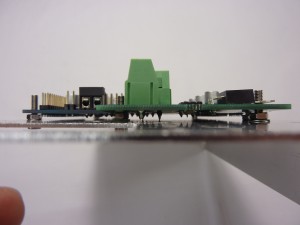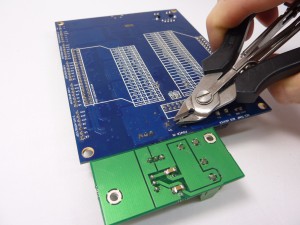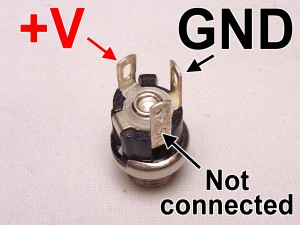Contents
Goal
| By the end of this section, you will have mounted the Duet electronics in it’s enclosure, and mounted it on the printer. |  |
Wiring the Duet
The Duet electronics board controls all the functions of the printer. We use an external 5V regulator board to provide good, clean 5V power.
| Take the 5V regulator PCB. Push the M3x8mm cap head screws into the two mounting holes; one goes through the MOSFET. Secure with an M3 washer and M3 nut on the back. Both sides of the 5V regulator PCB are shown here. |  |
| Take the DC power link wire (the short, wide, grey piece of wire). Cut open the length of 2-core and earth copper cable and extract the blue and brown cores. |  |
| Strip both ends of each core as shown. These dc-power-links should be about 16mm long, with 6mm of exposed wire each end, and 4mm of insulation. |  |
| Make sure that the screw gates of all the screw terminals are OPEN. The gate on the left is open, the one on the right is only partially open. They are usually supplied closed, so unscrew them first, before inserting any wire. The screw terminal is tightened by turning the screw clockwise. If the wires are not tight in the terminals, they will not make a good connection, and possibly cause heat to be generated. |  |
| Insert the dc-power-links into the Duet’s POWER IN screw terminals, and tighten the screw terminals. Make sure the blue and brown wire insulation IS NOT TRAPPED by the screw terminals, or you will have a poor connection. These wires carry a lot of current (for the heated bed), so poor connections can get hot. Cut the insulation shorter, or leave it off, if you need to. |  |
| Push on the 5v regulator PCB and secure to the Duet by tightening the screws of the 5v regulator PCB’s power output terminal. Again, make sure the blue and brown wire insulation IS NOT TRAPPED by the screw terminals, or you will have a poor connection. |  |
Mount the Duet in the enclosure
Assemble the electronics enclosure using the following parts:
|
 |
| Take the enclosure-base. All the aluminium parts may have oil on them; wipe them over with a paper towel to remove the oil, and any swarf that may be left over from the cutting process. You can clean them up with a little fine-grade sandpaper, or wire wool. Check that the slots are clear – the perimeter is usually quite a tight fit. |  |
| Fit the M3x18mm stand-offs onto the corners of the Duet board, each with an M3 nut on the back. Leave these loose, for some ‘wiggle’ room fitting the board. |  |
| You’re going to trial mount the Duet PCB, to check that there are no short circuits to the metal case underneath the boards. Place the Duet board on the enclosure-base, making sure all six screws go through the base. The nuts under the Duet act as spacers between the Duet board and the enclosure-base. You can lightly screw on more M3 nuts behind if you want. | Picture to come |
| IMPORTANT: Look between the Duet board and the enclosure base. You do not want any of the soldered pins on the back of the board to touch the metal of the enclosure base. If they are touching and power is applied to the board, it will short circuit, and potentially damage the board. |  |
| Trim any long pins with a pair of side cutters. |  |
| Check again that there is nothing in danger of contacting the enclosure base. Once you are happy nothing is touching, remove the Duet from the enclosure-base. |  |
| You can also put strips of Kapton tape (which is electrically insulating) on the enclosure-base, under the Duet. |  |
| The Duet enclosure-perimeter comes pre-bent to shape. Fit it to the enclosure-base as shown; check you have it oriented correctly. CARE SHOULD BE TAKEN WITH ITS SHARP EDGES. There are three slots in the enclosure base at each end, which correspond to the tabs in the enclosure perimeter. Make sure they are aligned, then slot the two parts together as shown; a fair amount of pushing force is required to push the tabs into the slots. Put a pieces of Kapton tape over the edge of the perimeter as shown – the ‘expansion header’ pins are over this area. |  |
| Place the Duet assembly in the enclosure. Line up the screws, so they go through the mounting holes. |  |
| The USB connector is the longest part. Check it comes through the hole at the end, and that the SD card socket and ethernet socket line up. |  |
| Once the Duet is in place, and the screws are showing through the enclosure base, tighten the four M3 nuts under the Duet. If you push down on the board, the M3 nuts should bite enough to tighten, turning the M3x18mm stand-off. A 5mm spanner is very handy, but you can do this with a pair of pliers. |  |
| Secure the Duet and the 5V regulator PCB with six M3 nuts on the back of the enclosure-base. Make sure they are securely tightened. The one that goes through the MOSFET of the 5V regulator is particularly important; it is used to heatsink this to the enclosure back. Make sure it is securely fixed. |  |
| Now fit the DC power cable. If you pull back the braiding, you should see one of the two white wires has a black stripe. Use the wire with the black stripe as the negative/ground wire. |  |
| Push the cable up through the hole in the enclosure, and feed the ferrules into the screw terminals. This is quite a tight fit – you may need to heat the heatshrink to shrink it a little more, so it comes up through the hoe easily. Make sure the wire with the black stripe goes in the ‘-‘ (negative/ground) screw terminal, not the ‘+’ (positive) terminal. |  |
| The completed assembly. |  |
Mounting the enclosure on the frame
|
 |
| Mount the power jack in the hole at the bottom of the enclosure. |  |
| Fit the three duet-bar-clamps to the frame, in roughly the positions shown in the picture. |  |
| Offer the enclosure up to the frame. Push the M3x35mm cap head screws through the enclosure holes, and then through the printed part. Secure them with an M3 nut on the back. The nut should pull into the nut trap in the printed part. |  |
| Connect the DC power cable to the tabs on the back of the jack. Ground is the centre of the three tabs (the wire with the black stripe should connect to this), and positive is the tab that connects to the centre pin. |  |
| Make sure the crimps do not touch. This is the jack viewed from underneath the printer. You can’t route the cable over the frame, or the Y carriage will hit the wire. Once connected, check the Y carriage can move past the wire without contact. |  |
Fitting the enclosure lid
|
 |
| Like you did for the enclosure-base, check the slots in duet-enclosure-lid are clear. Push the duet-enclosure lid onto the rest of the enclosure, noting it’s orientation from the picture. The tabs in the enclosure perimeter should engage with the slots in the lid. Secure with the four M3x12mm cap head screws, which screw into the M3x18mm standoffs in the Duet. Finally, remove the lid. The next section deals with wiring, and you will need to access the Duet to connect the wiring looms. |  |
Enclosure fitted
| The Huxley Duo with the electronics and enclosure fitted. |  |

